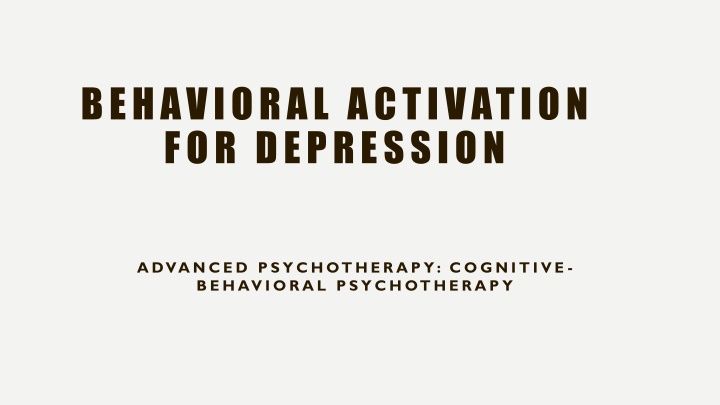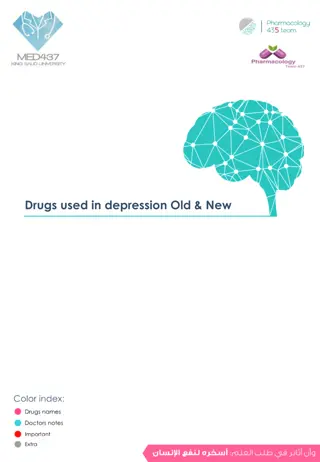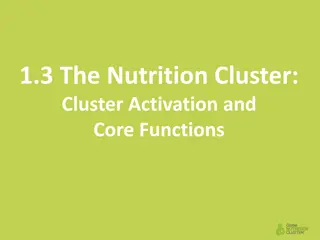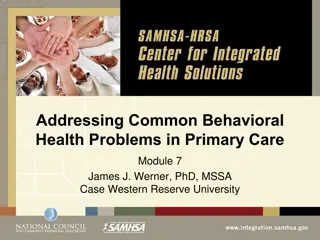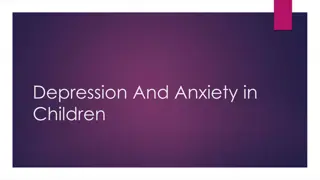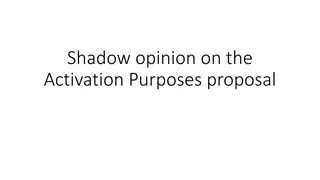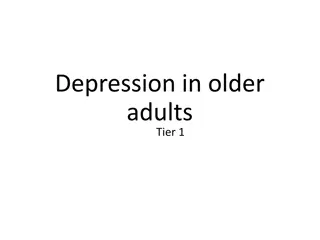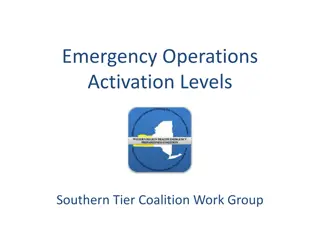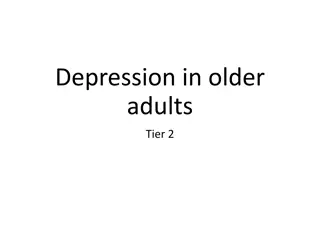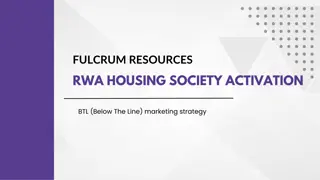BEHAVIORAL ACTIVATION FOR DEPRESSION
In-depth exploration of Behavioral Activation Therapy for depression, focusing on environmental influences and avoidance behaviors. Learn about treatment principles and session-by-session plans to improve mood and engagement in meaningful activities.
Download Presentation

Please find below an Image/Link to download the presentation.
The content on the website is provided AS IS for your information and personal use only. It may not be sold, licensed, or shared on other websites without obtaining consent from the author.If you encounter any issues during the download, it is possible that the publisher has removed the file from their server.
You are allowed to download the files provided on this website for personal or commercial use, subject to the condition that they are used lawfully. All files are the property of their respective owners.
The content on the website is provided AS IS for your information and personal use only. It may not be sold, licensed, or shared on other websites without obtaining consent from the author.
E N D
Presentation Transcript
BEHAVIORAL ACTIVATION FOR DEPRESSION ADVANCED PSYCHOTHERAPY: COGNITIVE - BEHAVIORAL PSYCHOTHERAPY
OBJECTIVES Understand a behavioral conceptualization of depression. Understand a session-by-session plan for behavioral activation.
BACKGROUND Neil Jacobson (PhD) is best known for developing and testing behavioral activation. His research showed that the behavioral component of CBT (called behavioral activation) was a effective as a full CBT treatment package. Carl LeJuez (PhD) refined behavioral activation and provided free treatment manual and materials for clinicians. Lots of scientific support for the efficacy of behavioral activation. Today s class focuses on this treatment.
BEHAVIORAL CONCEPTUALIZATION OF BA Focus on environmental influences as opposed to intrapsychic causes Focus on lack of positive reinforcement in environment and aversive environment Depression is an individual s best attempts to respond to environment using unhelpful strategies mostly AVOIDANCE Avoidance = disengaging from problem solving and engaging in the environment Avoidance = using short-term coping strategy on a long-term basis What are some examples of avoidance? Staying in bed; binging on Netflix
BEHAVIORAL CONCEPTUALIZATION OF BA Avoidance -> lack of engagement in pleasurable/meaningful activities -> worsened mood -> lack of engagement in pleasurable/meaningful activities Pull Away & Do Less Feel Down
IMPORTANT TREATMENT PRINCIPLES The key to changing how we feel is changing what we do. Changes in life (e.g., stress, trauma, bad relationships, disappointments) can lead to depression. To figure out what will improve mood, we will examine what occurs before and after important behaviors. This allows us to determine what behaviors worsen mood and what behaviors improve mood. Activities will be structured and scheduled following a plan, not a mood. Instead of not doing anything like our mood tells us, we want to follow our plan. This will involve engaging in activities that once led to pleasure, provide a sense of accomplishment, or that solve current problems. Change will be easier when starting small.
IMPORTANT TREATMENT PRINCIPLES We will emphasize activities that are more likely to bring forth a natural reinforcement (e.g., healthy eating, exercise, sleep hygiene tips, etc.) Your provider will act as a coach and help you plan strategies, make suggestions, give direction, and keep up morale. We will emphasize a problem-solving approach in which we help develop, evaluate, and try out potential solutions. Don t just talk, do! Practice assignments are required in each and every session. We will troubleshoot possible and actual barriers to activation.
SESSION #1 Session One Key Elements: 1. Discussion of Depression 2. Introduction to Treatment Rationale What about stressful life events and loss in your life? 3. Introduction to Daily Monitoring (Form 1) Importance and Enjoyment Ratings When should you complete the Daily Monitoring Form? 4. Important Points about the Structure of This Treatment Assignments: 1. Complete Daily Monitoring Form
SESSION #2 Session Two Key Elements: 1. Daily Monitoring: Review Assignment (Form 1) Troubleshooting 2. Treatment Rationale: Review 3. Complete Life Areas, Values, Activities Inventory (Form 2) Assignments: 1. Complete Daily Monitoring (Form 1) 2. Review and Edit Life Areas, Values, and Activities Inventory (Form 2) 3. Review Appendix 1: Moving from Life Areas and Values to Activities
SESSION #3 Session Three Key Elements: 1. Daily Monitoring: Review Assignment (Form 1) 2. Life Areas, Values, and Activities Inventory: Review Assignment (Form 2) 3. Activity Selection and Ranking (Form 3) Assignments: 1. Daily Monitoring (Form 1) 2. Continue to Review and Edit Life Areas, Values, and Activities Inventory (Form 2) 3. Review and Edit Activity Selection and Ranking
SESSION #4 Session Four Key Elements: 1. Daily Monitoring: Review Assignment (Form 1) 2. Daily Monitoring with Activity Planning (Form 1) Assignments: 1. Daily Monitoring with Activity Planning for upcoming Week (Form 1)
SESSION #5 Session Five Key Elements: 1. Daily Monitoring with Activity Planning: Review Assignment (Form 1) 2. Contracts (Form 4) 3. Daily Monitoring with Activity Planning for the Upcoming Week (Form 1) Assignments: 1. Daily Monitoring with Activity Planning for the Upcoming Week (Form 1) 2. Continue Adding/Editing Contracts (Form 4)
SESSION #6 Session Six Key Elements: 1. Daily Monitoring with Activity Planning: Review Assignment (Form 1) 2. Contracts: Review Assignment (Form 4) 3. Daily Monitoring with Activity Planning for the Upcoming Week (Form 1) Assignments: 1. Daily Monitoring with Activity Planning for the Upcoming Week (Form 1) 2. Continue Adding/Editing Contracts (Form 4)
SESSION #7 Session Seven Key Elements: 1. Daily Monitoring with Activity Planning: Review Assignment (Form 1) 2. Life Areas, Values, and Activities Inventory: Concept Review and Edit (Form 2) 3. Daily Monitoring with Activity Planning for the Upcoming Week (Form 1) Assignments: 1. Daily Monitoring with Activity Planning for the Upcoming Week (Form 1) 2. Continue Adding/Editing Contracts (Form 4)
SESSION #8 Session Eight Key Elements: 1. Daily Monitoring with Activity Planning: Review Assignment (Form 1) 2. Activity Selection and Ranking: Concept Review and Edit (Form 3) 3. Daily Monitoring with Activity Planning for the Upcoming Week (Form 1) Assignments: 1. Daily Monitoring with Activity Planning for the Upcoming Week (Form 1) 2. Continue Adding/Editing Contracts (Form 4)
SESSION #9 Session Nine Key Elements: 1. Daily Monitoring with Activity Planning: Review Assignment (Form 1) 2. Contracts: Concept Review and Edit (Form 4) 3. Daily Monitoring with Activity Planning for the Upcoming Week (Form 1) Assignments: 1. Daily Monitoring with Activity Planning for the Upcoming Week (Form 1) 2. Continue Adding/Editing Contracts (Form 4)
SESSION #10 Session Ten and Beyond Key Elements: 1. Daily Monitoring with Activity Planning: Review Assignment (Form 1) 2. Daily Monitoring with Activity Planning for the Upcoming Week (Form 1) 3. Preparing for the End of Treatment Assignments: 1. Daily Monitoring with Activity Planning for the Upcoming Week (Form 1) 2. Continue Adding/Editing Contracts (Form 4)
